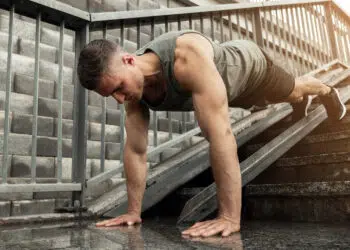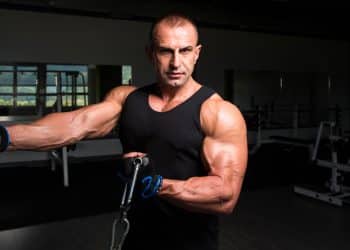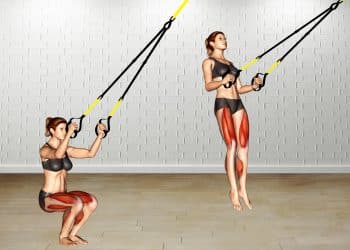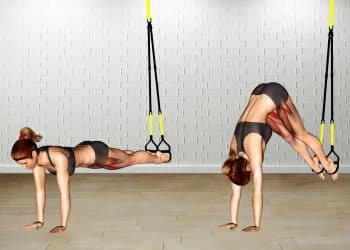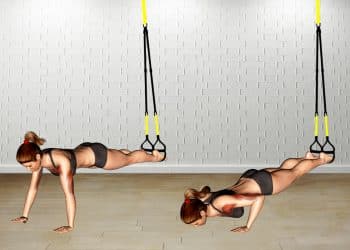Neither typically a beginner nor advanced-only technique, suspension inverted rows, also called the TRX low row, are a hybrid technique that combines both a back row and pull-up. Hanging onto straps with your posterior dangling above the floor and only heels touched down, the objective is to overcome the instability of a free swaying suspension setup while also training the back and arm muscles symmetrically. Giving functional training a whole new meaning!
But, in our opinion, the inverted row, regardless of the style, is such an underrated movement that can also be used as a progression to full pull-ups. And if you have a good balance between pulling strength and body weight resistance, it can be a powerful weapon that you “pull” out when needed.
So let’s not waste any time, or gains, and get straight to the good stuff!
How To Do The Suspension Inverted Row
A low-hanging version of the bodyweight row/pull-up, the suspension inverted row involves the next level of pulling strength compared to a more upright variation. But it also requires the ability to stabilize yourself so that you can pull with optimal strength and technique. Therefore, we recommend this exercise for those with some suspension training experience.
Note: We recommend setting up on an anchor point that doesn’t limit your movement, like a power rack, overhead bars, etc. Although a door may work if the straps are long enough.
Steps
Before you begin the exercise, adjust your straps so that when you’re hanging from them with your arms extended, your body is roughly parallel to the floor. Then you’re ready to perform the suspension inverted row in just three steps!
Level Up Your Fitness: Join our 💪 strong community in Fitness Volt Newsletter. Get daily inspiration, expert-backed workouts, nutrition tips, the latest in strength sports, and the support you need to reach your goals. Subscribe for free!
Step 1: Setup and body position
Use one of the two following techniques to get in the starting position.
Sit on the floor under the straps then reach up and grip the handles. Then come up onto your heels, pull your shoulders back, stick your chest up, and form a straight line with your body, including your head. Feet should be roughly hip width apart for optimal balance, and range of movement. Avoid hyperextending or keeping the knees too straight as it could put a lot of pressure on the knee joint.
Or,
From the standing position, grip the handles then bend your elbows (For safety), and walk yourself underneath the straps, like shown in the video included below these written instructions. Maintain the same body position with your shoulders retracted, body straight, and abs tense.
Step 2: The row/pull
If starting with your arms straight, drive your elbows behind you and pull your back muscles to the rear to lift yourself up. Squeeze at the top.
Note: If you start with the arms in a bent position, simply lower yourself down under control, then perform step 2 before you proceed to step 3.
Step 3: Slow and controlled negative
Now slowly straighten your arms evenly to lower yourself toward the floor while maintaining the same strong body position.
That’s the suspension inverted row! Then all you have to do is repeat steps 4 and 5 for the desired number of repetitions until you complete one set. Do another two sets for three sets total.
Here’s an excellent demonstration of the suspension inverted row with verbal instruction, and 5 sweet variations that we will also mention in the variations and alternatives section below.
Pro Tips
- Notice how in the video demonstration, the elbows are neither tucked into the side or flared out very wide. This seems to be an optimal angle where you get the best of strength performance and shoulder protection.
- Keep the shoulder halfway retracted rather than fully pulled back. This will allow you to get some stretch during the eccentric part of each rep, while also giving you the stability and strong pull in your back and scapular muscles.
- You should feel a more intense connection in your muscles by lifting your chest a little more as you pull up.
- Make sure to keep your body nice and long, but avoid fully extending the knees for their safety.
- Always make sure to double check the secureness of your suspension straps to avoid injuries.
This Exercise
- Target muscle group: Back
- Type: Hypertrophy and strength
- Mechanics: Compound
- Equipment: Suspension straps and anchor point
- Difficulty: Intermediate
Benefits Of The Suspension Inverted Row
One of the more hardcore bodyweight exercises, there’s nothing wimpy about the suspension inverted row. Here we’ll go over all the reasons why you need to be doing this high end movement.
Big back, gun show, no weights required…
You don’t need barbell rows and dumbbell curls to build a ridiculous back and head turning arm muscles. That’s the interesting thing about using your body as resistance. While your body is a fixed weight, there are techniques to create more resistance by simply changing the angle of your body.
In the case of suspension inverted rows, this is how you can easily make it harder so you never run out of ways to progress.
- Start with a horizontal body, then progress to the feet elevated, advance to using additional weighted objects (Vest, chain, bands), try your hand (Not two hands) at the single arm inverted row, and finally, gain more body weight to make all of the above more challenging.. what?! It’s a legitimate technique, okay!
Not a basic row
While you’re not doing any circus acts, conventional rows aren’t done on an apparatus that can swing you around. But that’s what suspension straps are even though we won’t use them that way. With some practice, you shouldn’t have a difficult time performing suspension inverted rows. But the fact remains you need high stabilizer muscle engagement compared to an unmoving bar setup.
Tons of variations for all experience levels
While this guide primarily focuses on the suspension inverted row, we still have to offer easier, and high level alternatives. After all, we have them so if you need them no need to go looking elsewhere. Now, as mentioned under the first benefit above, you can do all sorts to increase the training load.
But if you need an easier option, simply stand up rather than lay almost parallel to the floor. Also called just the suspension row as it’s the default technique, this will significantly unload the movement and make it possible for really just about anyone.
Common Mistakes During The Suspension Inverted Row
While it’s a powerful exercise, you could reduce its potency by doing these common mistakes.
Hollow body
Look we’re not doing hollow body pulls here. If you resemble a hammock then you’re totally doing it wrong. In fact, you should be pushing that chest up, activating the hips and core, and driving those shoulders partially back. Sinking pecs and protracted arms are a big no no for this exercise. This will set your muscles to pull with maximum force and efficiency.
So be sure to keep proper alignment to get the most reps and muscle stimulation.
Sticking your elbows out
There’s a time, place, and level of resistance for flaring the elbows wide in an exercise. The suspension inverted row isn’t one of those instances.
While you don’t need the arms pinned to your sides and we don’t recommend it, the movement should feel natural both for your shoulder joint, and the position where you can pull with the most strength. This is typically somewhere between elbows fully tucked into your torso, and them being all the way flared out.
Suspension inverted biceps row
If you didn’t catch that, this common mistake is using too much biceps, and not focusing on the larger back muscles. If you want to curl, then curl. But this is a row, and why waste energy training smaller arm muscles, when you could get one of the best back workouts and train the entirety of your upper posterior.
Variations And Alternatives Of The Suspension Inverted Row
So what if you don’t have suspension straps or the TRX? Can you still achieve the same thing? Not quite, because you still need the instability factor which is what makes the suspension inverted row unique. However, any variation of inverted rows, whether using a more sturdy platform or moving straps is one of the best, underused back exercises, in our opinion.
So you’ll find both suspension row variations and similar alternatives below.
Suspension bent leg inverted row
If you like the parallel angle of an inverted row but need a regressed version or you prefer the feeling of bending your legs, then it’s another option for you. Simply bend your legs, and recreate the same technique.
Suspension inverted row W/ feet elevated
The simplest, most minimal, and hassle free way to make a suspension inverted row more challenging is to do it with your feet off the ground. This will shift some of the weight from your legs to your upper body.
Suspension inverted row W/ weighted vest, chains, or resistance bands
A little more inconvenient is to strap on a weighted vest, hang some chains over you, or anchor down some resistance bands, like demonstrated in the primary video example included in this guide under the section ‘How to do the suspension inverted row’.
Suspension inverted row W/ underhand grip
You’d be surprised by how just switching your hand position can make an exercise feel different even if you’re training the same muscle. Take a barbell bent over row for example or better yet, try both an overhand and underhand yourself, and we bet you’ll feel the two variations differently.
Why? Your grip can actually determine the movement mechanics and how comfortable a position and technique feels. Like when using an underhand grip, it may place your shoulder in a safer position if you’re pulling the hands toward the lower abdomen. Whereas an overhand grip will be ergonomic if pulling the bar or straps toward the chest.
Level Up Your Fitness: Join our 💪 strong community in Fitness Volt Newsletter. Get daily inspiration, expert-backed workouts, nutrition tips, the latest in strength sports, and the support you need to reach your goals. Subscribe for free!
But does it make a difference in your gains?
Well, it very well could if you’re feeling better muscle activation. And you’ll have found an exercise technique that feels good which means you’ll be more willing to stay consistent.
Suspension row
What’s the difference between a suspension row and inverted row? So the inverted row implies the opposite position of a bent over weighted row, or pulling the load from the floor.
A suspension row usually describes a more all-training-level-friendly variation, and a basic rowing technique performed from a standing position. The typical default technique when teaching suspension techniques to beginners, especially.
How to do it:
- Make sure your trainer is secured to an overhead object. When the straps are hanging, the handles should be just above knee height when you’re standing up, give or take a few inches.
- Next grip your handles with the palms facing in, then walk back away from the anchor point until the straps are tight.
- Then straighten your arms and drop back, letting the straps hold you up while keeping your body in a straight line including your head.
- Perform one rep to see if your position is challenging enough for the target muscles. If not, walk your feet forward which will drop your body lower and create more resistance during the movement. The more upright your body, the less challenging the resistance. If you found the right position, you’re ready to start your set.
- Before your first rep, slightly retract your shoulder blades, and tense your core muscles for optimal muscle engagement.
- Now bend your arms and pull yourself up as high as you can.
- Slowly straighten the arms to drop back down into the starting pose.
Watch a few minute tutorial on the suspension back row via the YouTube clip included below.
Suspension single arm row
When you’re ready for final boss mode then you can and should try this sick variation. The instability will make it so much more challenging but that’s what you’re up for, right?
Unless you already possess the abilities to just jump into the suspension one arm row, the following video walks you through several progressions to prepare you for this master level bodyweight back exercise.
Smith machine/barbell inverted row
A more stable, beginner friendly alternative, the Smith or barbell inverted row removes instability with a secured bar on a rack. And, this is arguably the most common way to perform an inverted row. Also called the Australian pull-up, you’ll be happy that this exercise is an option for your back training.
Suspension inverted row W/ rings
Rings do something similar, and are typically used for gymnastics training. But they’re also a sick way to build your body. Plus, the different style of handle, or ring may feel more ergonomic, or keep things exciting. So, yeah, if you have access to rings, try to hit a few sets of suspension inverted rows.
Do it like this and you’ll get incredible results.
Table inverted row
No suspension straps or bar and rack? You can use a sturdy table as long as it can support your body weight (And you don’t mind leaning your weight onto your table). Be very careful when you do this one and inspect your table, if possible, especially if you’re a little uncertain about whether you’re table will consistently hold you up, and endure repetitive pull-ups.
We understand that there are many different types of tables and actually many can work.
It can look something like this.
And if you want more resistance, here’s a creative way to make that happen.
Any other row
Whether it’s any free weight row variation, cable row, machine row, or band row, any row will work all the same muscles as suspension inverted rows. Although you won’t get the additional functional benefits of an unstable apparatus. Still, if your goal is just muscle and strength, then it doesn’t matter which option you choose, as long as you’re implementing progressive overload.
Muscles Worked During The Suspension Inverted Row
An interesting fact about pull-up and row variations is that they work every muscle from the feet to the muscles under the bumpy bone on the back of your head. That includes your hips, core, lower back, spinal muscles, all back muscles, rear shoulders, anterior arm muscles, and even your neck too. Yeah, it covers a lot of backside.
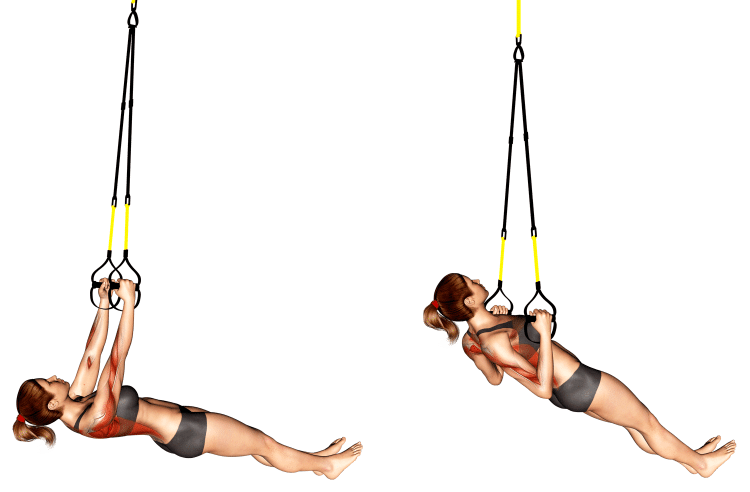
Infraspinatus
The “I” in “SITS”, which is a reminder for the four rotator cuff muscles, supraspinatus, infraspinatus, teres minor, and subscapularis, infraspinatus helps its cousins to stabilize and make possible multi-directional movement of the shoulder joint.
Latissimus Dorsi
A wide and bold muscle that asserts its size on the posterior chain, latissimus dorsi is most apparent on a lean and muscular physique. Appearing like bat wings that stick out under the armpit, and a sight to see in a front lat spread pose, the lats act on the shoulder blades to move the shoulders in different ways. A common action of the lats is when you perform pull-ups.
Teres Major
Yet another component of the posterior muscles that move the arm, teres major is secured to both the scapula and upper arm bone where it works with your lats to medially rotate, adduct, and extend the humerus (Upper arm bone).
Teres Minor
The “T” is SITS as one of the muscles that contribute to rotator cuff function, teres minor is a key muscles in all pulling motions.
Trapezius Lower Fibers
The back has no shortage of powerful muscles that move the scapula. The lowermost of three parts making up the trapezius shaped group of back muscles, lower fibers create downward movement of the shoulder blades.
Trapezius Middle Fibers
Move slightly north above the lower fibers and the middle traps pull the shoulder blades back in retraction. This helps create good movement alignment for optimal back activation.
Trapezius Upper Fibers
Planted across the upper back with fibers that run to the occipital head bone. Upper traps lift your scap north.
Brachialis
The secret muscle helping fill out your shirt sleeves, brachialis fibers are both in the upper arm next to the outer biceps, and run down through into the forearm. Due to its impressive anatomy, brachialis is a prominent elbow flexor.
Brachioradialis
Starting from roughly the middle of your elbow crease and expanding to the top, knuckle side of your forearm, brachioradialis also enters the upper arm through the elbow joint. It consequently helps bend the arm between the forearm and biceps while also rotating the forearm both ways.
Biceps
Move over other muscles because biceps need no introduction. Split into two heads, biceps stretch from the forearm up the front arm and thread into the shoulder joint. It therefore flexes the arm at the elbow and helps flex the arm anteriorly. Pulls help create dream biceps!
Deltoid Posterior
Peak over your shoulder and you’ll find the deltoid posterior or rear delt. While you seldom see the back shoulder, we know that’s got our back (literally) when it comes to movements that involve rear movement of the back muscles.
Core
Packed in your trunk or torso are crucial muscles that protect your spine and lower back, prevent you from collapsing during heavy lifts, and create a base for energy transfer of muscles. These include the six pack abdominals, deeper core muscles, obliques, and other back muscles.
Hips
While you wouldn’t think of the hips as a muscle involved in rows, they help the trunk create stability and straight and strong body position for optimal force transfer.
FAQ’s
How should I program the suspension inverted row?
For any workout session, we recommend everyone aim for 2-3 sets minimum, and 6-20 reps.
These are good ranges for sufficient muscle stimulation, building strength, muscle gains, and avoiding overtraining.
Although, when it comes to bodyweight resistance exercises, you’ll need to determine which positions allow you to achieve specific rep ranges, alternating the intensity between sessions. And depending on various training factors (i.e., resistance, overall training regime, and equipment used), you can include suspension inverted rows at any point during an exercise session.
What's the difference between a suspension inverted row vs. suspension row?
The inverted row implies the body is closer to a parallel angle, so that pull occurs in the exact opposite path as a conventional bent over row exercise.
The suspension row, on the other hand, could technically describe both variations, however, it’s more commonly recognized as a basic suspension trainer row movement.
Who should do the suspension inverted row?
Anyone with suspension row training experience, and sufficient pulling and total body strength. The instability of free swinging straps combined with a more advanced suspension pull technique is not ideal for the absolute beginner.
Wrapping Up
An oftentimes hidden but powerful pull workout weapon, the suspension inverted row is a clear winner when it comes to bodyweight back exercises. And its variations as just as awesome! But what makes the suspension inverted row really stand out is the fact that the straps are always moving, even if just slightly. So you need the right technique, proper body positioning, and movement control to train your muscles most effectively.
And that’s why it’s an excellent workout for developing the more functional aspects of fitness, not just pure hypertrophy and strength. But the ability to create a whole system that works together for optimal performance output.
Interested in measuring your progress? Check out our strength standards for Machine Row, Dumbbell Curl, Pull Ups, and more.


